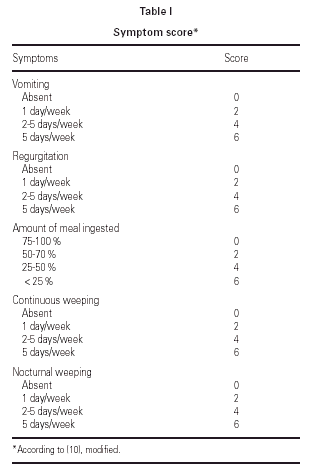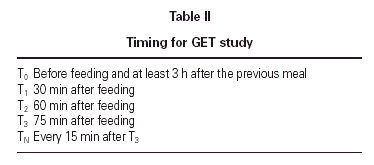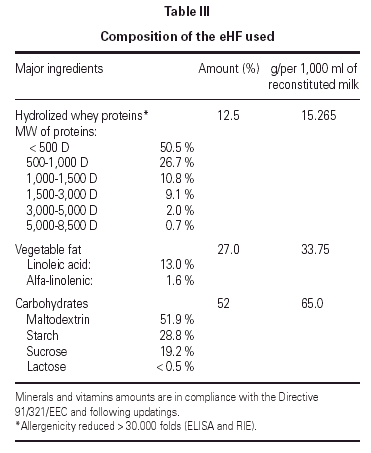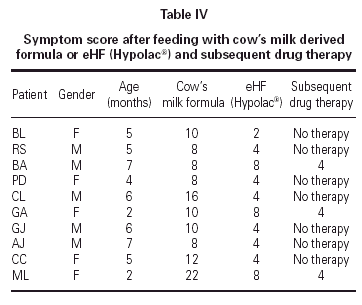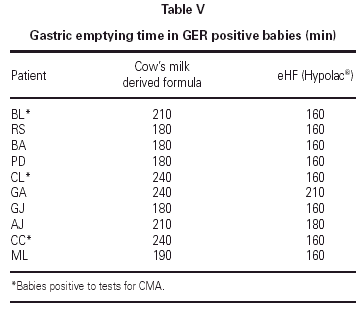INTRODUCTION
The Gastro Esophageal Reflux (GER) is a well-known clinical condition during the paediatric age, highly increased during the last decades and involving nowadays more than 20 % of infants (1). The clinical picture linked to GER can be quite variable, with symptoms mainly related to the digestive apparatus (typical forms) or involving other apparatuses (atypical forms). Heavy symptoms such as oesophagitis or oesophageal stenosis are rarely seen during the first months of age.
The Gastro Esophageal Reflux-Related Disease (GER-D) is a condition with a multifactorial aetiology, but usually caused by abnormalities of the lower oesophageal sphincter with subsequent alterations of the oesophageal clearing, increase of the Gastric Emptying Time (GET) associated with high intragastric acidity levels, or abnormalities of the gastric mucosa barrier (2).
About 1/3 of infants with GER-D suffers also from Cow's Milk proteins Allergy (CMA) and this condition is considered to be responsible for the GER-D during the first months of life. The diagnosis of GER is essentially based on clinical criteria, but the change of symptomatology with age must be taken into account. The clinical picture may involve:
Typical symptoms such as post-prandial regurgitation, irritability, vomiting, weeping, refuse of feeding and rumination.
Atypical symptoms such as involvement of the respiratory tract with recurrent pulmonary episodes, recurrent laryngitis with dysphonia, laryngomalacia, chronic pharyngitis, chronic otitis, sinusitis, Sandifer's syndrome, asthma and symptoms related to upper airways obstruction and also respiratory blockade associated to apparent life-threatening episodes (ALTE).
Patient's clinical history is usually confirmed by pHmetry results, although this test is most useful in patients with atypical symptoms.
In patients suffering from GER-D, an elimination diet and the use of foods designed for CMA give excellent results (3-5). Moreover, in the last years, dynamic echography is being increasingly used to prove lower oesophageal sphincter abnormalities, to show important GER or, mostly, to test if the GET is pathologically increased.
We have therefore planned our trial to test the efficacy of an extensively Hydrolysed Formula (eHF) in subjects with an abnormally high GET and clinical symptoms of GER and also to evaluate if a non-invasive method such as dynamic echography can be considered suitable as a routine diagnostic approach in these infants.
MATERIAL AND METHODS
Selection of patients
Ten infants in the age range 2 to 6 months (4.9 months on average), exclusively fed with cow's derived formulae and with clinical symptoms of GER were enrolled.
The control group included 10 infants in the age range 4-6 months (average 4.7 months) exclusively fed with cow's milk derived formulae, without clinical symptoms of GER and not taking any kind of drug during the test period.
The experimental protocol was approved by the local Ethics Committee. Parents were informed about the aim and the techniques used for the study and gave their consent to take part.
Diagnosis of CMA
All selected babies with clinical symptoms of GER underwent routine tests for food allergy to exclude or to prove a concomitant CMA.
The following test were performed:
1. Skin prick-test (Prick-by-Prick with the cow's milk derived formula used for feeding and with a low-allergenicity eHF, both diluted in a 1:10 ratio in water before use).
2. In vitro determination of specific IgE to cow's milk (CAP method, Pharmacia, Uppsala, Sweden).
Symptom scores for the evaluation of clinical symptoms of GER
According to the experimental design detailed below, all parents of the selected babies suspected of GER were asked to fill in a diary for symptoms according to the scoring system shown in table I. Babies presenting an average weekly score > 7 were included.
Instrumental GET evaluation
The GET was evaluated through an echotomographic study using a colour duplex scanner with a 3.5 MHz linear probe; the procedure end point was to determine the total gastric volume, and required the following steps:
Identification of the gastric antrum by localisation of the upper mesenteric trunk and determination of both the longitudinal and cross-section diameter.
Calculation of the gastric volume according to the following formula:
V = π A (B/4)2.
V = gastric volume.
A = longitudinal diameter.
B = cross-section diameter.
The gastric volume was determined for each subject before feeding and then during the digestive phase according to the steps shown in table II. Stomach emptying was considered complete as soon as gastric volume went back to the initial volume.
Experimental design
Phase 1
Parents of each selected subject, normally fed with cow's milk derived formulae, were asked to register for one week all suspected GER-related symptoms, as detailed in table I. Subsequently, the GET was determined for each selected subject after feeding with cow's milk derived formulae.
The GET was determined with the same procedure in a parallel group of 10 healthy subjects fed with cow's milk derived formulae.
Phase 2
At the end of phase 1, the cow's milk derived formula was substituted by an eHF normally used for CMA therapy (Hypolac®, ALK-Abellò S.p.A.), with very low allergenicity checked by means of immunoenzymatic methods. The composition of this eHF is given in table III.
Symptoms detailed in table I were recorded again for one week by the babies' parents during this phase, whereas the GET was determined in each subject at the end of this second observation period.
Statistical methods
The inter- and intra-group GET analysis for the two kinds of milk used for feeding were performed with the ANOVA test. A non-parametric test (Mann Whitney U-test) was used for the inter-group analysis of clinical scores with each kind of milk.
Statistical analysis was done by means of a standard commercial software (BMDP Inc., Los Angeles, U.S.A.).
RESULTS
Clinical symptoms of GER
The average daily clinical score in infants suspected of GER and fed with cow's milk derived formulae turned out to be 11.2. After switching to the eHF (Hypolac®), the average daily value decreased to 5.0 and this difference turned out to be statistically highly significant (p = 0.0039) (table IV). Only 3 out of 7 infants suspected of GER but negative to in vivo and in vitro tests for CMA needed drugs to control their symptoms after switching to the eHF.
CMA
Skin prick test and specific IgE determinations performed in all infants suspected of GER showed a positive response to milk in 3 out of 10 subjects (RAST class ≥2; wheal diameter ≥5 mm). These subjects are identified in table V. None of them was, conversely, positive to skin prick tests with the eHF.
GET
Babies suspected of GER showed an average GET of 205 ± 26.77 minutes when fed with cow's milk derived formulae. After switching to Hypolac®, the average GET decreased to 167 ± 16.36 and this difference is highly significant (p < 0.001) (table V). Healthy babies fed with cow's milk derived formulae showed an average GET of 124 ± 9.66 minutes (table VI), this value being significantly different in comparison to the value shown by the other group (p = 0.000).
The three subjects suspected of GER and also positive to tests for CMA showed the highest reduction of GET in comparison to patients suspected of GER but negative to tests for CMA (30.44 % vs 12.5 % statistical analysis not possible because of the low number of subjects).
DISCUSSION
The GER is nowadays a very common pathology in infants but, according to the literature publishing so far, about 1/3 of subjects becomes symptom-free after switching to cow's milk free diet (3, 6). Allergic oesophagitis has been recently carefully revised in a very important publication (7). In another paper it has been proved that the introduction of a mixture of aminoacids (Neocate SHS®) in a group of ten children with severe GER and eosinophilic oesophagitis (partly already submitted also to surgery with the aim to overcome the problem) was able to stop symptoms in all of the studied subjects and to provoke the disappearance of the oesophageal eosinophilic infiltrate (8).
The diagnosis and the documentation of the GER can be currently performed employing different methods. X-rays of the upper digestive tract, intraoesophageal long-lasting pH-metry (9) and scintiscan are valuable techniques. There are also methods evaluating the relationships among symptoms and GER (test according to Bernstein), tests documenting the damage of the oesophageal mucosa (endoscopy with histologic examination of the biopsies) and also double-contrast radiography.
According to the literature, the GET is normally increased in GER-positive patients (10-12). Since the aim of our trial was to compare the GET after feeding the infants with two different kinds of milk, we have chosen dynamic echography, an economic and sensible non-invasive technique.
We have confirmed these findings by dynamic echography showing that the GET is higher in subjects with a clinical diagnosis positive for GER compared to healthy subjects when both groups are fed with a cow's milk derived formula. Switching to an eHF caused a significant decrease of the GET in all subjects, including 3 subjects with a clinical diagnosis of GER and also positive to tests for CMA who showed the highest reduction of GET. Moreover, apart from the decrease of the GET, the use of a low-allergenicity eHF (Hypolac®) led to a significant improvement of symptoms in 7 out of 10 subjects suspected of GER.
These results are in agreement with previous similar observations reported by other investigators.
Our data support the hypotesis of two different combined actions for low allergenicity eHF. The first, linked to an immuno-allergological mechanism in infants positive to tests for CMA, due to the lack of allergenic proteins in the eHF used; the second, linked to the faster digestion of proteins already partly hydrolysed or to a faster passage through the stomach due to the fats and carbohydrates contained in Hypolac®. The final result is, likewise, a shorter food transit time through the stomach.
The non-invasive nature of the technique we employed allows for and encourages the performance of larger studies with the aim of stating the normal and pathological GET in different paediatric ages.
We believe that other studies with more cases and the evaluation of other functional parameters are needed to confirm our results.




